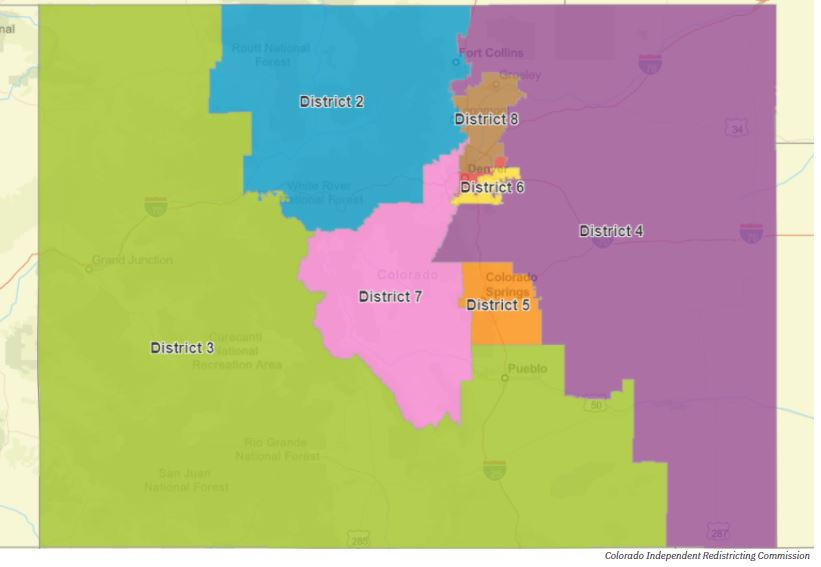Congressional Redistricting Commission finishes their task

SAN LUIS VALLEY -— In a final meeting that ultimately lasted roughly six hours with the sixth and final vote reaching consensus held just minutes before the midnight deadline, the Colorado Independent Congressional Redistricting Commission finally came to an agreement on the map that, pending approval by the Colorado Supreme Court, will establish the eight new Congressional districts in the state of Colorado.
The district boundary lines generally give the current officeholders a strong chance of holding their seats with four Democratic districts, three Republican districts and the eighth district drawn as a swing district that leans very slightly to the left.
Some Democratic observers were dissatisfied with the map finally approved by the commission, with one political consultant stating that having a fourth district that could potentially swing conservative is “absurd” in a state that elected Joe Biden by a 13 point percentage. David Pourshoushtari, spokesman for the Colorado Democratic Party, said that political competitiveness – one of the criteria to be used in drawing districts – came “almost exclusively at the expense of the Democrats.”
In the course of discussions, political competitiveness was clearly a consideration as the discussion grew tense at various times. But it was not the only consideration as, at one point, one map was being supported by two Republicans and two Democrats.
Ultimately, population, the criteria with the strictest requirements allowing a deviation of only one person, was a key determining factor. Also, in a strong nod to one very important community of interest, the eighth Congressional district is heavily Hispanic, something that has not existed in prior existing Congressional districts in Colorado.
As far as the San Luis Valley is concerned, some pundits are saying that the third district as drawn on the new map is a “win” for U.S. Rep. Boebert, the ultra-conservative Republican from Garfield County, as several strong liberal communities like Lake County and Steamboat Springs were cut out of CD 3 and strong Republican counties on the Eastern Plains – specifically, Las Animas, Otero and Crowley – were added. Boebert, a first term member of Congress, was elected by a margin of 6 percentage points in November, 2020. The new map favors her by nine points, based on previous voting results.
Also, Democrat and state senator Kerry Donovan of Vail, who had already raised more than $1 million in a bid for the nomination to run against Boebert, was drawn out of CD 3 and put in CD 2, represented by Democratic Congressman Joe Neguse. Donovan could still take on Boebert since members of Congress don’t have to live in the district they represent, but that is clearly a disadvantage.
However, unlike previous maps where they had been drawn out, Sol Sandoval Tafoya and State Representative Donald Valdez now clearly reside in the newly drawn CD 3 where they hope to challenge Boebert in 2022.
Even with the pros, cons, compliments and criticisms of the final map, the process and final discussion leading up to its adoption was a display of democracy at its finest.
There were numerous references by members of the commission to specific comments they had heard from the public and a genuine, collective motivation to abide by strong requests they had heard in both comments and testimony. There was also sincere appreciation expressed for the level of involvement displayed by the people of Colorado with the submission of roughly 170 maps drawn and submitted by members of the public, organizations and various groups along with more than 5,000 comments submitted by individuals online.
The commissioners themselves also displayed exemplary dedication to their appointment to the commission and the charge they had been given. They held twice as many hearings with the public as what was required and continued to participate in meetings, even if that was done “from a hospital room”, while “at a funeral” or “in a car by the side of the road while on vacation with the family”.
And, as does not happen nearly enough in today’s political climate, at the end of a long, grueling, complicated and sometimes very tense process that lasted more than six months, Democrats and Republicans and Unaffiliated voters spoke of each other with nothing but deep respect, high regard and even affection.
Ultimately, the people of Colorado were the winners in this process, and so was democracy. The ability to disagree – even to be in open conflict, at times – but ultimately reach a consensus for the good of the people and the representation of all is a lesson that has tremendous merit. And it is, indeed, a lesson worth learning that extends outside the borders of Colorado, across these fifty states and all the way to the House of Representatives where those eventually elected in the eight districts of Colorado will serve.
The proposed Congressional map will be delivered to the Colorado Supreme Court on October 1 where it will undergo judicial review.



